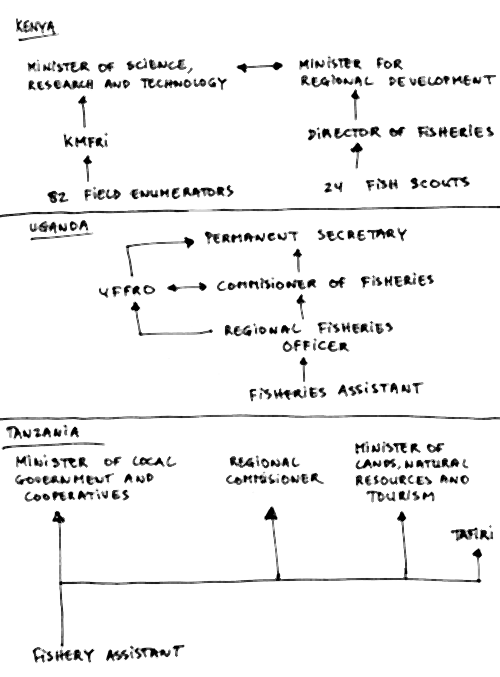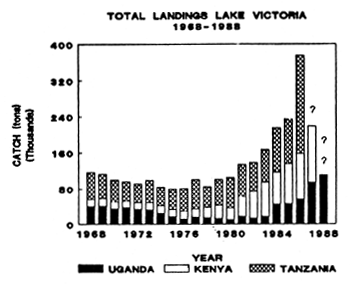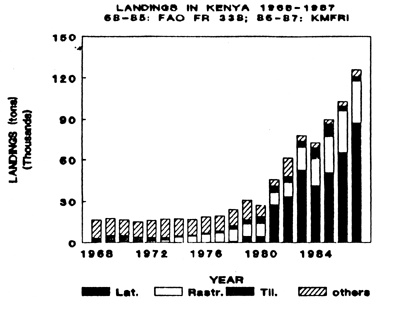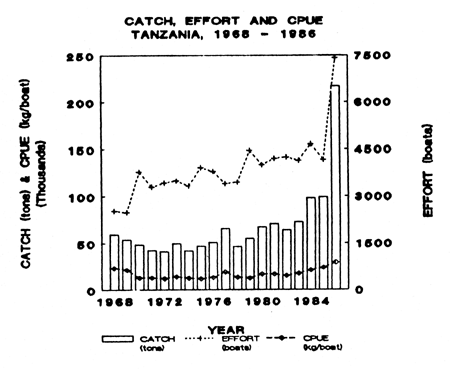By
E. Coenen & F.L. Orach-Meza.
March 1989
1. INTRODUCTION :
By action of FAO Headquarters (FIO), Dr. F.L Orach-Meza, National Director of Project UGA/87/007 “Rehabilitation of Fisheries Statistics and Information Systems” and Deputy Commissioner for Fisheries, and E. Coenen, CTA of the above project, were authorized to attend the HEST/TAFIRI & FAO/DANIDA regional seminar about “fish stocks and fisheries in Lake Victoria”, held in Mwanza (Tanzania) from 9/1/1989 to 25/2/1989 from 15 through 25 February 1989 as observers and at project expense.
2. ITINERARY AND PROGRAM :
| 15/02/1989 | : | - | Entebbe to Mwanza by plane; |
| - | Reporting to Immigration and Customs Office in Mwanza town; | ||
| - | Introduction to organisers and participants of the seminar. | ||
| 16/02/1989–21/02/1989 | : | - | FAO/DANIDA course of dataprocessing for stock assessment; |
| - | screening of documents; | ||
| - | visit to the Regional Fisheries Office of Mwanza. | ||
| 22/02/1989–23/02/1989 | : | - | lectures and discussions on Lake Victoria fisheries development and management; |
| - | evaluation of the seminar. | ||
| 24/02/1989 | : | - | closing lecture and official closure of the seminar; |
| - | distribution of certificates. | ||
| 25/02/1989 | : | - | reporting to Immigration and Customs in Mwanza; |
| - | visit to the Kirumba fishlanding in Mwanza. | ||
| 26/02/1989 | : | - | returnflight Mwanza - Entebbe. |
3. PERSONS MET :
Abbreviations used in the following list include : TAFIRI = Tanzania Fisheries Research Institute; KMFRI = Kenya Marine and Fresh Water Fisheries Research Institute; UFFRO = Uganda Freshwater Fisheries Research Organization; ODNRI = Overseas Development Natural Resources Institute; HEST = Haplochromis Ecology Survey Team.
List of persons met :
Ms. O. Mukongo, TAFIRI, Mwanza (Tanzania).
Mr. Katunzi, TAFIRI, Mwanza (Tanzania).
Mr. J. Kashindi, TAFIRI, Mwanza (Tanzania).
Mr. J.A. Mwanbungu, TAFIRI, Shirati (Tanzania).
Mr. B.S. Msuku, TAFIRI, Shirati (Tanzania).
Mr. A. Getabu, KMFRI, Kisumu (Kenya).
Mr. P.B.O. Orhumba, KMFRI, Kisumu (Kenya).
Mr. C. Rabuor, KMFRI, Kisumu (Kenya).
Mr. A. Asila, KMFRI, Kisumu (Kenya).
Mr. J. Ogari, KMFRI, Kisumu (Kenya).
Mr. Wandera S. Bwaku, UFFRO, Jinja (Uganda).
Mr. J.S. Balirwa, UFFRO, Jinja (Uganda).
Mr. L. Menebaza-Ndawula, UFFRO, Jinja (Uganda).
Mr. D. Ocenodongo, UFFRO, Jinja (Uganda).
Mr. T.O. Acere, UFFRO, Jinja (Uganda).
Mr. P.O. Bwathondi, Director TAFIRI, Dar-es-Salam (Tanzania).
Mr. Kathonda, Director TAFIRI, Mwanza (Tanzania).
Mr. R. Nzyoka, Director KMFRI, Kisumu (Kenya).
Mr. A.W. Kudhongania, Director UFFRO, Jinja (Uganda).
Mr. Z.K. Mulegi, Regional Natural Resources Officer, Mwanza (Tanzania).
Mr. Mutolera, Regional Fisheries Officer, Mwanza (Tanzania).
Dr. D. Pauly, International Center for Living Aquatic Resources Management (ICLARM), Manila (Philippines).
Ms. M.L. Palomares, ICLARM, Manila (Philippines).
Mr. P. Degnbol, Danish Inst. Fish. Mar. Res. (Denmark).
Mr. J. Rogers, ODNRI, London (England).
Mr. A.S. Tariq, ODNRI, London (England).
Mr. W.L.T. Van Densen, Agric. Univ., Wageningen (Netherlands).
Mr. T. Buyse, Agric. Univ., Wageningen (Netherlands).
Mr. W. Ligtvoet, HEST, Mwanza (Tanzania).
Mr. J. Wanink, HEST, Mwanza (Tanzania).
Mr. K. Goudswaard, HEST (Tanzania).
4. OBSERVATIONS AND CONCLUSIONS :
The computerexercises of the participants (5 researchers from each of the researchinstitutes of the 3 riparian countries of L. Victoria) of the FAO/DANIDA course of dataprocessing for stock assessment were observed from 16 to 21 February. The participants analysed their own data by use of ICLARM (Elephan) software in view of preparing scientific papers. Discussions with individual participants about data collection and analysis in general were held. Available documentation on Lake Victoria fisheries in general and especially on data collection and analysis of catch and effort data in the 3 countries were screened. As requested, a summary draft of the 1988 L. Victoria catch data from Uganda (Fisheries Department) were presented to the seminar organisers for further discussion.
A visit was paid to the Regional Fisheries Officer in Mwanza on the 21th of February to obtain information about the system used in the region for catch and effort data collection, analysis and reporting. A useful discussion was held with the officer.
From 22 to 23 February 1989, lectures and discussions on L. Victoria fisheries management were held:
Coenen and Orach-Meza presented the project objectives and the initial and planned activities of project UGA/87/007 “Rehabilitation of Fisheries Statistics and Information Systems” in Uganda and thanked the organisers of the seminar for the opportunity offered to them to be present at the seminar;
Pauly and Degnbol (FAO/DANIDA) gave a lecture on different types of fisheries management strategies (tactical and strategic management) with exercises for the participants.
Van Densen of the Agricultural University of Wageningen headed a discussion on the conclusions, recommendations and organisation schemes prepared earlier during the seminar by the participants, on the existing and their proposed possible fisheries regulations concerning minimum fish size, minimum mesh size and fishing effort for Lake Victoria for Lates, Rastrineobola and Tilapia, on the question of how to manage the L. Victoria fisheries once the catches would start to decrease or should the fisheries collapse (and wether regional management was possible) and on the proposal for annual meetings of the biologists-researchers of the 3 countries including the question of funding by EEC, CIFA, etc.
On 23 February the participants of each country were asked to present, discuss and compare the existing structures of responsabilities in fisheries management and development decision making, of the organisation schemes of their respective research organisations and of the governmental institutions with a clear indication on the flows of information, e.g. on catch and effort data from landings, on consultation and decisions and on fisheries regulations. Evaluation forms for the FAO/DANIDA course, a proposal of the “top ten” recommendations (see Annex 1) for future research and development actions (prepared by participants) and a proposal for monthly biological observations (see Annex 2) on Lates, Rastrineobola and Tilapia at different landings sites in each of the 3 countries around L. Victoria were distributed.
The assessment of the FAO/DANIDA course by the participants gave a overall high and positive score. The global evaluation of the whole seminar revealed the following overall conclusion : the seminar, instead of consisting of a lot of lectures on different topics (too much a one way “class-type” info flow), should have been directed to a more active participation of the participants who would have preferred that each of them would have an opportunity to present and discuss his research results with the others in view of preparing scientific papers.
The participants of Uganda, having to leave that same afternoon, expressed words of thanks to the organisers of the seminar and were given certificates and some scientific research equipment.
The 24th of February started with a closing lecture by W. Van Densen on “Biological and management aspects of the regional seminar on Lake Victoria fish stocks and fisheries” (see Annex 3) stressing the need for annual meetings to update and discuss the information on catches, effort, catch composition and population parameters (in view of a regional management of the Lake Victoria fisheries) and for looking into ways of funding these regional meetings and possible future regional training sessions.
The Party Secretary of the Mwanza region then proceeded with the official closure of the seminar and the issue of certificates and scientific equipment to the remaining participants of the seminar. Final statements and words of thanks were later given by the Directors of the Research Institutes of the 3 countries and by a representative of the participants. Finally, a priority ranking of the “top ten” recommendations on future research was discussed without however reaching a final ranking consent.
We visited the Kirumba Fish Landing, Mwanza, during the last day of our stay. Lates niloticus, Tilapis spp., Rastrineobola argentea and Protopterus sp. were the most common species observed, but Haplochromis spp., Bagrus sp. and Labeo sp. were also present. Landing and market facilities for landing, cleaning, processing and selling of the fish were non existent. Tons of sacs of dried Rastrineobola (“ndaga”), about 40 kg each and sold at about 50 Tanzanian Shillings (= about 0.38 US $) per kg, were lying on the beach waiting for transport to Dar-es-Salam, Rwanda, etc. Fresh and ndaga dried on large flat rocks are for human consumption while ndaga dried on sand is mainly for chicken food. Nets made locally from tyre twines (60 m long, 25 meshes deep and of 7 inch meshsize) were sold on the beach for T. Shs 3000 each.
We wish to conclude that our participation in the last part of the seminar was a good opportunity for us to discuss catch and effort data collection and analysis systems of Lake Victoria fisheries with researchers and officials of different countries and to sense the need for more refined and harmonized (regional) data collection systems and management measures for the Lake Victoria fisheries - especially at the moment when overall catches would start to decrease -, to have contacts with different research and fisheries officials of the 3 countries in view of organising future actions (study tours, workshops, etc) in connection with our project and to gather overall useful information on Lake Victoria fisheries in general and on systems of fisheries data collection and analysis in particular.
Annex 1
Top ten recommendations (Not in order of reference)
Regular sampling for Lates, Rastrineobola and Oreochromis and limnological p[arameters to establish distribution (temporal and spatial), breeding and factors affecting the above
Collaborative lake-wide survey especially for the deeper waters; fish tagging (when Ibis becomes operational) in the three states.
assessement of stock sizes of Lates, Rastrineobola, Oreochromis and planctonic and bentic organismes with studies of energy transfer through the lake ecosystem.
Taxonomy of Tilapiines (and to what extent hybrids occur) and Lates and whether these form definite stocks
Biological observations of artisanal fishery at the landing (see proposal)
Definition of effort - seminar participants to decide on
Frame survey - involving both fisheries departments and research institutes
Catch recording at beaches which should be provided with sheds, recording equipement and materials including identification booklets for beach recorders
Strengthening of the statistical sections at the research institutions through material support
Organisation of future research - through regular meetings, time scheduling and exchange of any relevant literature including internal reports
Annex 2
proposal.wp
Proposal
Recommendations with respect to ‘biological observations at the landing sites’
A monthly sample of 500 Rastrineobola, caught with mosquito nets, to be measured to the nearest 0.5 cm standard length.
The results of the routine observations and their analysis should be made available to the 2 other riparian countries and for the annual meeting of the Lake Victoria biologists.
Rastrineobola in Kenya and with tilapiines in Uganda. For Tanzania this is difficult to tell. In the statistics until 1986 the catch of Rastrineobola seems to diminish, but this species is probably recorded in dry weight in Tanzania. The catch per major category in Kenya shows the rise of Rastrineobola since the seventies, whereas Nile perch came up in the eighties (fig. 4).
Every manager, not necessarily a fisheries biologist, can imagine that this recent development in the catches, together with the ecosystem shift, could not go on forever. The fishermen reacts to the higher availability (standing stock biomass) of fish by increasing its fishing effort. This is clear from the recent rise in the number of boats in Tanzania (fig. 5). When the fishery would over-exploit the stocks of Nile perch, the first signal probably will come from a smaller mean size in the catch. To this the fishermen will react by lowering their mesh sizes. Could this process be halted via mesh size and effort regulations? The participants inventoried existing regulations and proposed new ones, most of the time in addition to existing ones (table 6). From the table it is clear that the management for Nile perch and Rastrineobola is still in its initial stage. Interesting was the idea that sometimes only absolute regulations (closed areas, closed seasons) are feasible because of the enforcement problems with other types of regulation (mesh size, fishing effort). Another interesting ‘external’ regulation was the possibility of fixing a minimum mesh size by allowing the manufacturing of these and larger gillnets only, and to forbid the import of other gillnets (Kenya 4" gillnets). With the minimum fish and mesh sizes proposed the Nile perch is still relatively young, circa 1–1.5 yrs. old, when it recruits to the fishery (to).
The biology of the major fish species was dealt with via the chapters on taxonomy, autecology, synecology and fish stock assessment. Emphasis was laid upon a critical approach on length-frequency analysis (LFA), an appropriate tool for tropical fisheries biologists to estimate growth parameters. Experience in the further use of LFA in fish stock assessment was gained during the 2-weeks FAO/DANIDA-course in data-processing and in writing a scientific paper.
The comparison of growth between lakes showed that circa 50 cm Nile perch grows at least twice as fast in Lake Victoria as in other lakes referred to in the literature (fig. 7). Other parameters like natural and fishing mortality and recruitment are more difficult to estimate. During the seminar it was concluded that the stocks of Nile perch must have expended in recent years even under the constraint of a fast developing fishery. This became most clear from the comparison of the present yield with the maximum sustainable yield (MSY) estimated by Ssentongo & Welcomme (1984) for Nile perch in the Ugandan and Kenyan part of Lake Victoria: 34,500 tons. They thought it possible that the Nile perch stock in the heavily fished Nyanza Gulf was already over-exploited. The yield of Nile perch in the Kenyan part of the lake was 90,000 tons in 1987. This again shows the enormous output of the system, the fast shift within the system and the uncertainties the fisheries biologists and managers have to deal with for the time being.
At the moment there might be all kind of constraints (technical, funding etc.) on the fisheries research on the lake, but for the near future one major aspect deserves special attention: the regional organization and training of the Lake Victoria fisheries biologists.
With respect to organization a proposal has been worked out by the 15 participants to have annual meetings to update and discuss the information on catches, effort, catch composition and population parameters. Ways must be found to have funding allocated specifically for this organization and possible further training.
During the seminar it has been shown how to use the tables in the reports of CIFA/sc Lake Victoria for making graphs and so to characterize the developments in the fishery more easily. Second, with a minimum set of observations and the related (wo)man-power invested, one could easily follow the developments in the catch and so in the stock. Such observations could encompass the monthly recording of the size structure of the catch of Nile perch and Rastrineobola at 3–5 major landing sites per country. It was a pitty that this type of observations were not available on such a scale from every country during this seminar and that such information is very scarce for Rastrineobola especially.
Knowledge on the spatial pattern of the fishery and the fishing industry was acquired via the mapping of the fishery. This nicely showed the major fishing grounds, landing sites and transport roads. This mapping is beneficial in the stratified sampling of the fishery, most necessary when there is 1 fisheries biologist per 4,600 km2 of lake area.
Finally I would like to thank everybody who has contributed to the success of this seminar, especially the HEST-members. Frans Witte and his colleagues did a tremendous amount of work on the preparation of the seminar in The Netherlands. Willem Ligtvoet coordinated the preparations in Tanzania. He and Jan Wanink wrote a review of Nile perch and Rastrineobola respectively on behalf of this seminar (see references). Kees Goudswaard fought all logistic problems coming up. Also I would like to thank TAFIRI, being the host of this seminar, and the directors of the institutes for cooperating in offering this opportunity for exchange of information between and training of Lake Victoria fisheries biologists. Ruud Crul and Frits Roest, both of the International Agricultural Centre Wageningen, and Tom Buijse of the Agricultural University Wageningen contributed to this seminar via their knowledge on limnology, fisheries and computer use. Daniel Pauly, Paul Degnbol and Deng Palomares organized the very stimulating FAO/DANIDA part of the seminar on data-processing and writing scientific papers. Daniel Pauly took the initiative to publish a book on Lake Victoria's fish stocks and fisheries. The results of the FAO/DANIDA part of the seminar, written up by the participants, will be part of the book. Not all who contributed in one way or another are mentioned here. It is without doubt that the motivation of the participants to learn about and to discuss fisheries science greatly contributed to the success of this seminar. Most convincing in this respect was the open mind of the two grand old men among the participants. Amongst other things their attitude made me to believe that this seminar was a good starting point, although it lacked two essential instruments: a photocopier and walls with pin-up board, wherever you look.
References
Ligtvoet, W. 1988. Appendix: Fish stocks and fisheries in Lake Victoria (Handbook to the HEST/TAFIRI/FAO/DANIDA regional seminar.
Reynolds, J.E. & Greyboval, D.F., 1988. Socio-economic effects of the evolution of Nileperch fisheries in Lake Victoria: a review CIFA Techn.rap. 17. 148 pp.
Ssentongo, G.W. & Welcomme, R.L., 1984. Past history and current trends in the fisheries of Lake Victoria. FAO Fish. Rep. no. 335. p. 123 – 138.
Wanink, J.H., 1988. Appendix: Fish stocks and fisheries in Lake Victoria (Handbook to the HEST/TAFIRI/FAO/DANIDA regional seminar.
Table 6. Existing and possible regulations inventories and proposed by the participants. The existing ones are underlined.
| Lates | Rastrineobola | Tilapia | ||
| minimum fish size | ||||
| Uganda | 48 cm | 4.5 cm | 28 cm | |
| Kenya | 50 cm | 4.0 cm | 25 cm | |
| Tanzania | 30 cm | - | 15 cm | |
| minimum mesh size (sm) | ||||
| Uganda | 12.7 cm | 10 mm | 12.7 cm | |
| Kenya | 15.2 cm | 10 mm | 10.2 cm | |
| Tanzania | - | 7.6 cm in bays | ||
| fishing effort | ||||
| Uganda | no seine nets | - | no monofil. | |
| no monofilament | no seine nets | |||
| gillnet <.90 m | closed areas: | |||
| <26 mesh deep | sand beaches | |||
| no fishing at night | boats < 7 m | |||
| boats <7 m | ||||
| Kenya | - | 8 nets of 25 m | ||
| closed season from | ||||
| 21/3 – 1/8 | ||||
| closed area: | closed area: | |||
| Kisumu Bay | Kisumu bay | |||
| Tanzania | no monof | - | no trawling in | |
| bays, | ||||
| closed season | ||||
| Jan - June | ||||

Figure 1. Characterization of the seminar on Lake Victoria fish stocks and fisheries, Mwanza, Tanzania, January – February 1989.

Fig. 2. National structures for gathering and processing catch/effort data (simplified versions).

Fig. 3. Total catches for Lake Victoria.

Fig. 4. Landings per major category for Kenyan waters 1968 – 1987.

Fig. 5. Catch, effort and CPUE for the Tanzanian part of Lake Victoria 1968 – 1986.

Fig. 7. The Gulland and Holt plot for nileperch in several lakes.